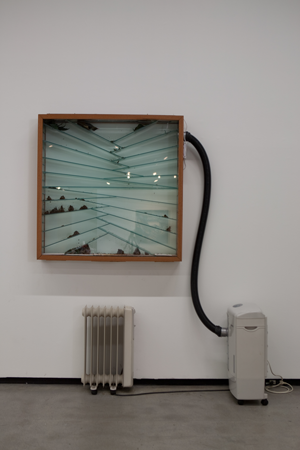Formigueiro/en
Ant colony
Theo Craveiro
Theo Craveiro considered many images of artworks that had an orderly and geometric structure which could be properly turned into an ant colony. He ended up creating an ambiguous situation when he chose, by intuition and affection, one of the paintings from the "Ideia visivel" [Visible idea] series by Waldemar Cordeiro.
One of the key works from the brazilian concretism — an important artistic movement from 1956 — "Ideia visivel" is today part of the collection of The Museum of Fine Arts, Houston in the USA, after having been sold along with about 100 other constructive and neo-concrete artworks by colector Adolpho Leirner, in 2007. The sale caused astonishment and debate amongst the brazilian art field, which grieved the loss of an important set of artworks that, according to the collector, could not be preserved (or taken care of) in the country.
The production of Cordeiro from the 50s, in tune with the concrete movement's program, tried to make visible a principle or idea. "The artwork does not contain an idea, it is in itself an idea", said the artist. To accomplish his goal, Cordeiro invented abstract artworks, oriented by the rationality of mathematics and by attempting not to make representations of reality.
When he appropriates the structure of the painting "Ideia visivel" to cultivate an ant colony, Theo Craveiro confronts Cordeiro's project and presents us reality itself (at least in a biological sense). The transparency of the work's glass makes visible the life of the artwork itself, which has to be taken care of and fed to remain alive. Food and proper climate conditions are provided to the ants through openings on the borders of the living being that this frame is.
While Cordeiro's paintings were a support for the investigation regarding art and its place in the construction of society according to operational molds and a modernizing rationality, ant colonies are indeed considered to be, at leat popularly, ideal societies in terms of organization, efficiency and neatness. However, the juxtaposition of these two universes — the artistic investigation and the organization of ant colonies — ultimately builds a complex and contradictory panorama as it makes visible the situation in which living beings — in this case ants — live and carry out their never-ending work not only trapped, but also inescapably subordinate to the macro-structure of an artistic program devised a priori.
